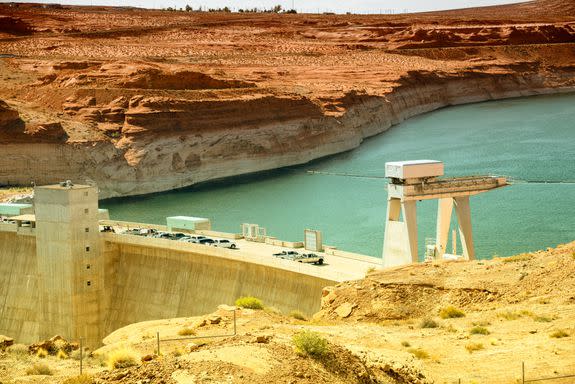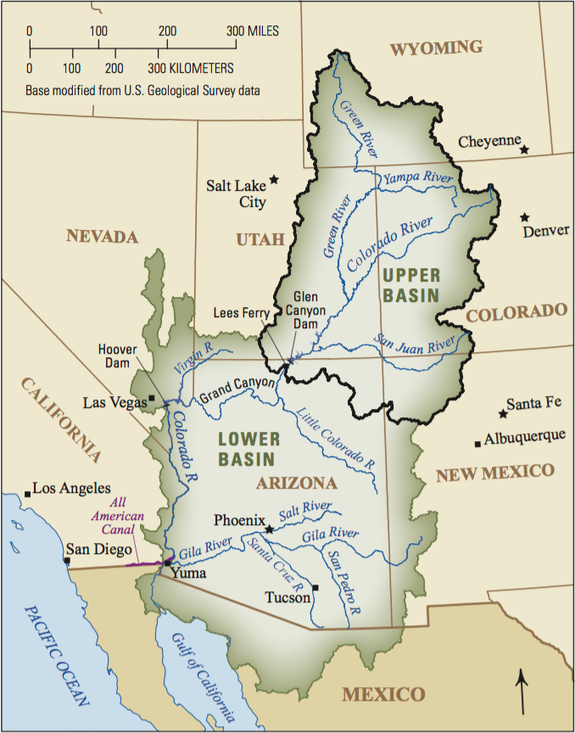The West accepts its drought-ridden future, slashes water use

Out West, the future is dry.
Amid an unprecedented 19-year drought in the expansive Colorado River Basin — which supplies water to 40 million Americans — seven Western states have acknowledged that the 21st century will only grow drier as temperatures continue to rise. And that means less water in the 1,450-mile Colorado River. On Tuesday, water managers from states including California, Utah, and New Mexico announced a drought plan (formally called a Drought Contingency Plan), which cuts their water use for the next seven years — until an even more austere strategy must be adopted.
Already, the drought has left water levels at Lake Mead — the nearly 250-square-mile reservoir that's held back by the formidable Hoover Dam — at their lowest levels in half a century. The water shortage has left telltale, white mineral "bathtub rings" around the basin, well over 100 feet high.
"This is a long anticipated step that clearly needed to happen," Brad Udall, a senior water and climate research scientist at Colorado State University who had no role in the plan, said in an interview.
"The bad news is we still have a lot of work left," added Udall. "As the climate continues to change and warm in the Southwest, all science shows that the river is expected to decline in the future."
"We all recognize we’re looking at a drier future," Tom Buschatzke, Director of the Arizona Department of Water Resources, said in a call with reporters on Tuesday.

Image: Shutterstock / GagliardiPhotography
The Colorado River and its reservoirs — though certainly not yet low enough to imperil millions of Westerners — are gradually evaporating while the desert land grows ever drier. The West is still expected to see yearly fluctuations in extreme precipitation, though the region can't escape the consequences of a steadily rising thermostat. "We'll continue to see odd and unusual climate extremes, both wet and dry," said Udall. "But these warmer temperatures just add an environmental load onto the system in very harmful ways."
Just how much are the West's rising temperatures and associated heat waves — so hot that they have grounded commercial jetliners in Arizona — drying out the winding Colorado River basin? A study coauthored by Udall last year found that climate change was responsible for half the Colorado River's flow declines over the last century (with other factors like less rain accounting for the other drops). Though, a 2017 study found this number to be a bit lower, at around one-third.
Either way, the climate effect is substantial and only expected to grow more potent: Over the last 40 years, Earth has experienced an accelerated warming trend and civilization's heat-trapping carbon emissions probably won't even peak for at least 10 more years. Already, the planet's carbon dioxide levels are likely the highest they've been in 15 million years.
"It's projected to continue to get warmer," said Ursula Rick, Managing Director of the University of Colorado Boulder’s Western Water Assessment, in reference to the Colorado River Basin.
SEE ALSO: The Green New Deal: Historians weigh in on the immense scale required to pull it off
Accepting the reality of hotter climes, the latest drought plans will manage the total supply of water, so that levels at the two greatest reservoirs, Mead and Powell, don't drop to levels that would trigger automatic water restrictions and a takeover by the federal government. Lake Mead currently sits at around 1,089 feet. If it ever fell to 1,075 feet, water rationing would go into effect.
"They’re [drought plans] meant to avoid a crisis on the river," Bureau of Reclamation Commissioner Brenda Burman said in a Tuesday call with reporters.
One important part of the plan allows upper basin states like Colorado to keep more water in Lake Powell (whose dam generates ample electricity for the region), rather than being required to send this water to the depleted Lake Mead — but only as a reward if upper basin states slash their water use. Meanwhile, lower basin states like Arizona and California are expected to cut their water use, too.

Image: USGS
Today's water woes are a significant departure from the 1980s and 1990s, fruitful times when Lake Mead even reached its storage capacity. The lake's levels were nearly 140 feet higher back then.
"We've never seen 19 years like this. It's unprecedented," said Udall. "The old ways of managing water in the West aren’t working and won’t work in the 21st century."
Although this latest drought contingency plan — which must now get approved by Congress — averts a near-term crisis, there's still a gaping hole in the scheme. California's thirsty agricultural Imperial Valley — which claims rights to a whopping 70 percent of all the Colorado River water the Golden State is afforded each year — did not agree to the plan. First, the Imperial Irrigation District wants $200 million in taxpayer dollars to fix the nearby environmental catastrophe that is the vanishing Salton Sea. (It's California's largest — and often stinkiest — lake, created by accident over a century ago, and is a long, winding water fiasco of its own.)
But in the future, with water only growing more limited, the powerful water district will almost certainly have to slash its ample share of water consumption. "They're going to have to contribute," said Udall.

Image: epa
The fate of the West over the coming decades, however, won't only be determined by water cuts and humanity's efforts to stymie climate change. It's dependent upon how many people choose to settle in the often idyllic, sun-blanketed Western world. "The growth of the region is a big unknown," noted the Western Water Assessment's Rick.
What's more, the ability of water to sustain the region is dependent on how people will want to live, said Rick. "Will they want yards? Will they want their food to be locally grown?" she asked.
In a warmer world, the state and federal government can intervene like they're doing now to avert water crises and maintain societal desires. Though, at some point, water demand may be too great for a burgeoning, thirsty West. "They can reduce demand — but only to a certain point," said Rick.
Now, states are watching the drought intently. It's evident that water managers see a water-limited future, stoked by climate change. Back in 2003, Udall noted that when he gave talks on future climate impacts to the water management community, he was sometimes given "dirty looks."
But 10 years later, that changed. By 2013, the unprecedented drought caused Colorado River reservoirs to plummet. A truly unsettling drought had set in. And it hasn't gone away.
"Somewhere around 2013 I think the light went on," said Udall, describing how many water managers began to accept the scientific realities of long-term drought and climate change. "The light went on that climate change is here, and now we gotta prepare for it."
WATCH: Ever wonder how the universe might end?


